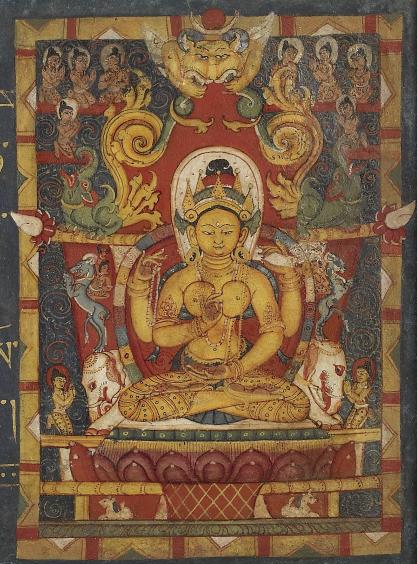This page is for research and translations on philosophical texts, in particular texts relating to the the view of emptiness/ultimate nature such as Empty-of-Other (Shentong).
1) Tāranātha’s Commentary on the Heart Sūtra . Translated and edited by Adele Tomlin. First edition, published by the Library of Tibetan Works and Archives, 2017. Second edition, Dakini Publications. 160 pages. English, with the Tibetan root text. Copies can be bought here.

A detailed study, translation and commentary on the Heart Sūtra written by Tāranātha (1575–1634), with extensive annotations from his longer commentary on the Sutra, The Previously Non-Existent Explanation of the Heart Sutra (shes rab snying po’i ‘grel ba sngon med legs bshad). Tāranātha is widely considered to be one of the most remarkable Buddhist scholars, translators and practitioners from Tibet.
In his commentary, Tāranātha succinctly distils his vast studies of Indian and Tibetan Buddhist thought on prajñāpāramitā and Buddha-Nature with the philosophical view of ‘Empty-of-Other’. The leitmotif of the text is Tāranātha’s five-fold assertion that the Sūtra ‘clearly teaches the Empty-of-Other Great Madhyamaka’. For Tāranātha, this confirms that ‘the intention of all three Turnings is the Empty-of-Other Great Madhyamaka’.
Tāranātha’s explanation is a valuable addition to the corpus of (Indian and Tibetan) translated commentaries on the Heart Sūtra. As a concise distillation of the Jonang view of Empty-of-Other and its connection to prajñāpāramitā, it provides the reader with a reasoned analysis as to why prajñāpāramitā involves not only ‘seeing’ that all phenomena are empty of intrinsic existence, but also realizing, via primordial awareness, that the ultimate nature is ‘unchanging’ and ‘permanent’, going beyond ‘impermanent’ conditioning, duality and mental elaborations.
In his foreword to the book, Prof. Matthew Kapstein (University of Chicago, Ecole Pratique des Hautes Etudes in Paris) states it is:
“…a valuable service to Tibetan Buddhist Studies. Her work, originally written as her M.A thesis, is clear and precise throughout, well-exemplifying the distinguished tradition of research on Buddhism at the University of Hamburg…..Ms Tomlin’s study may be recommended as a particularly attractive and accessible introduction to the Jonangpa’s distinctive doctrinal perspective.“
English language (contains the root text in Tibetan), 160 pages. If you would like a copy of this book posted to you, please contact me or the LTWA. All proceeds go to the LTWA.
A public lecture on this book and text was given at the Rangjung Yeshe Institute in October 2018 and is available to listen to here. There is a short introduction by Dr. Diane Denis who explains how the Zhentong view is often not represented, or misrepresented, in scholarly research, and the actual talk starts at 1.14 mins in.
For more about the book, and the new artwork on the cover of the second edition, created by master Tibetan calligrapher, Jamyang Dorjee, see here.
The Explicit and Hidden Aspects of Tārā: Commentary on the Twenty-One Tārās by Jetsun Tāranātha. Translated and edited by Adele Tomlin, Dakini Publications, 2020.
A short and beautiful commentary on the conventional and definitive aspects of the twenty-one Tārās by Tāranātha. In the text, Tāranātha also briefly teaches how the practice of Tāra is connected to the six vajra-yogas of Kālacakra. Free download here for those with both Tārā and Kālacakra empowerments.
Condensed Essence of Empty-of-Other by Jamyang Khyentse Wangpo
This text (click on the link for details) is an extremely precise, profound and clear explanation and presentation of the main points of the empty-of-other view and succinctly captures the central points that need to be understood. From this text, it is clear that Khyentse Wangpo follows the view of the Jonang Dolpopa, opening the text with the lines:
‘Here is a little explanation of the tradition of the Empty-of-Other Madhyamaka of the great Jonangpa Omniscient One [Dolpopa].
“Ultimate truth is indestructible, unconditioned and beyond interdependence. Conventional truth is phenomena that are born and decay, which gather together dependent on causes and conditions.”‘
Magic Key for Entering Knowledge by Khenpo Gangshar (9th Thrangu Rinpoche teachings)
Other Research/Posts
Jonang and the ‘Empty-of Other’ Great Madhyamaka: Excerpt from Introduction of Tāranātha’s Commentary on the Heart Sūtra (Tomlin, 2017)
MOTHER OF ALL THE BUDDHAS: PRAJNAPARAMITA AND THE ULTIMATE VIEW OF MIND AND REALITY
THE ‘MOTHER OF WISDOM’: Pictures, poems and songs on Mother’s Day!
NEW TRANSLATION: “Condensed Essence of Empty-of-Other” by Jamyang Khyentse Wangpo
The 8th Tai Situpa, Tāranātha, Shentong and the Golden Stupa at Sherab Ling
New Translations in Remembrance of Khenpo Tsultrim Gyamtso Rinpoche – Shentong yogi-scholar
HH the 14th Dalai Lama on the Jonang Kālacakra Six Yogas and Shentong – English translation
The Shentong View of Emptiness – A Short Introduction and Reader
Buddhist Tenets:

